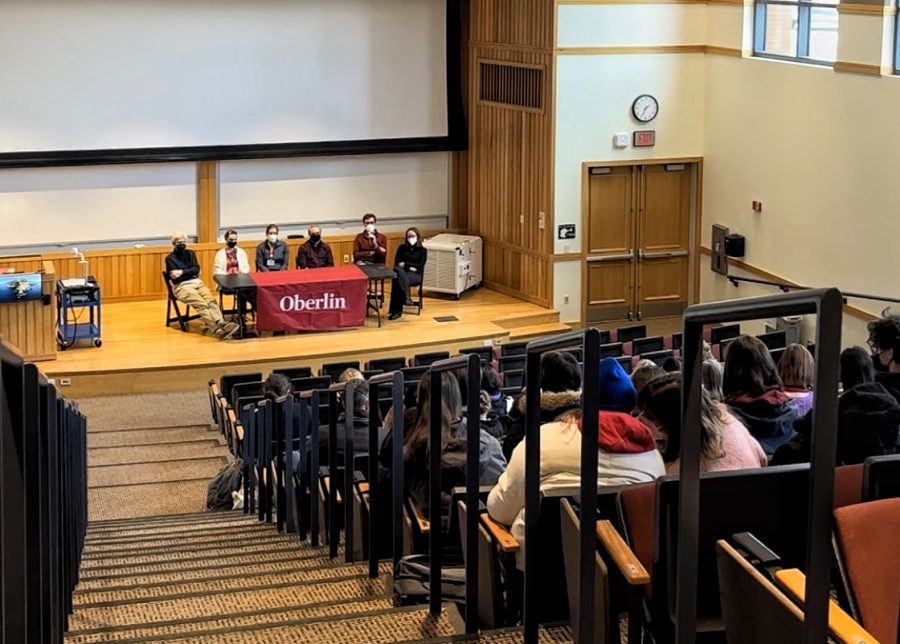Oberlin Meets Admissions Goals for Class of 2026, Receives Record Number of Applications
Students attend panel during All Roads programming.
After receiving the largest number of applicants on record, the College concluded the Class of 2026 admissions cycle on Monday, meeting its commitment goal for the year. The record number of applicants comes after increased efforts to lower barriers to apply and offer opportunities for both virtual and in-person recruitment.
“Arts and Sciences received 10,340 first-year applicants compared to last year’s 9,242, a 12 percent increase and an all-time high,” Dean of Admissions Manuel Carballo wrote in an email to the Review.
As a result of the large number of applicants, Oberlin was able to admit an academically strong class with higher GPAs than in previous years. The class of 2026 also has the largest number of U.S. students of color ever at 253 individuals, or 28.7 percent of the class, and the second-most recruited athletes ever at 118.
This year the College and the Conservatory have a combined 954 committed students, and plan to matriculate around 870, on-target for Oberlin’s goals for this year. Every year the College plans to lose about 10 percent of the incoming class to “summer melt” referring to students who decide to take a gap year or are no longer interested in attending Oberlin. Oberlin will continue to move some students off the waitlist in the summer months.
Over the past few years, Oberlin has implemented several policy changes to make the admissions process more accessible. This includes removing barriers such as the “Why Oberlin?” application essay, the application fee, and standardized testing requirements.
Oberlin has also introduced several financial incentives over the last year to make Oberlin more appealing, including the $10,000 Oberlin Commitment Scholarship, which will apply to students enrolling in fall 2023 onward and the $5,000 Oberlin Internship+ Commitment, which begins in fall 2022.
The College also had a strong year in terms of international applicants, although it admitted and plans to matriculate a similar number of students as it has in previous years.
“We have continued to see an increase in our international application pool, a 38 percent increase this year over last year … in no small part because of our current test-optional policy,” Carballo wrote. “With no international travel this cycle, we focused on Zoom sessions for our applicants to be able to connect with Oberlin and relied heavily on our current international students who helped us reach out to our admitted students.”
Going test-optional has helped Oberlin increase its number of international applicants. Senior Admission Fellow and College fourth-year Ryo Adachi sees the test-optional strategy as a way to relieve pressure on international students, especially since there are often fewer test dates offered in countries outside of the U.S., making it challenging for students to take standardized tests multiple times.
“It just got super competitive to get seats,” Adachi said. “So people were actually flying to different countries and different cities to take the SAT. So in that sense literally getting a seat in the test is super hard.”
Additionally, admissions has pursued a strategy of having international students in the office work to make personal connections with potential applicants and admitted students from the countries they come from.
“I had several Zoom calls with a lot of Japanese students, and one of them said that was one of their deciding factors to come to Oberlin,” Adachi said.
Some of the strong yield can be attributed to the All Roads Lead to Oberlin programming, which brought students to campus in the weeks before the commitment deadline. All Roads, which is normally an annual event, has not been held in person over the last two years due to COVID-19.
“I saw a lot of people forming friendships with each other and the students really having a chance to feel what the campus was in terms of, not just how admissions people reacted, but how the staff and people in town talk to you,” said Adachi. “I definitely have heard from students who decided to come to Oberlin and just really love their experience being here.”
Another addition to admissions efforts this year is a new TikTok account created to increase name recognition for the College.
“I was way too old to generate content by myself that wasn’t going to be cringy to anyone under 40,” Assistant Vice President of Admissions Communications Ben Jones wrote in an email to the Review. “So I teamed up with Nathan Carpenter (who knows everyone) and some of my more TikTok-savvy colleagues in the Admissions Office and we hired a small team of current students who had awesome ideas. We meet weekly in what we call the ‘writers’ room’ and workshop content pitches together for the following week, then they go out and film the ones that rise to the top.”
It is too early to determine if the account had any effect on yield, according to Jones, but he noted that the videos have received some engagement from students who applied this year, with their most popular video amassing over 400,000 views.
“I think of TikTok mostly as a vehicle that we use to get our name out there and introduce Oberlin to folks who haven’t yet heard of us, or who know very little about us, and get them excited enough to want to learn more about us,” Jones wrote.
A big motivation for creating a TikTok account was to exist on a platform that would appeal to prospective students from younger generations and allow the Admissions Office to post more fun and lighthearted content.
“I think it’s important for recruitment for us to show that Oberlin has a great sense of humor alongside its seriousness of purpose,” Jones wrote.





